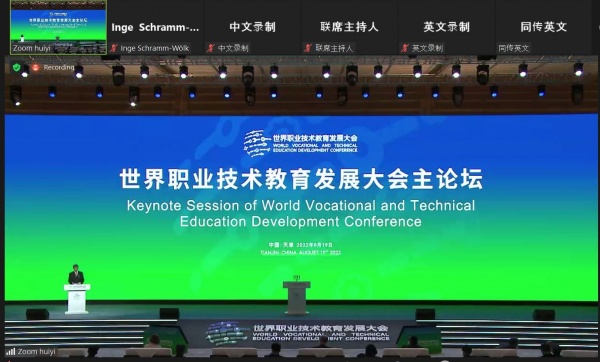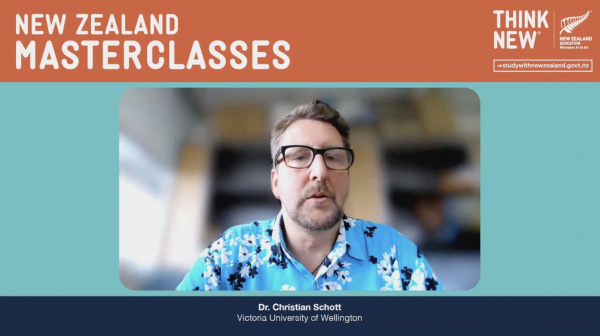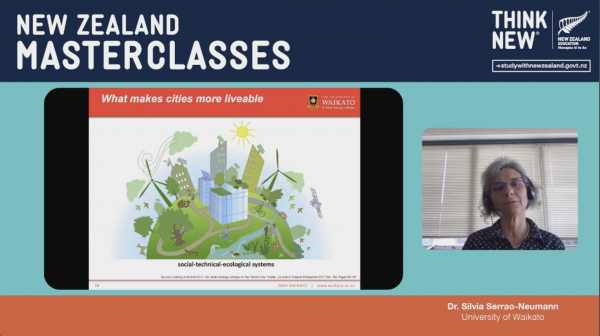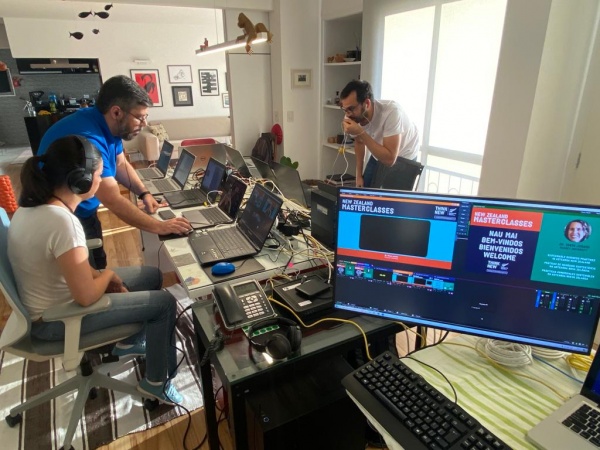Search
Showing 10 of 525 results for group registration
-
New Zealand – Korea digital student exchange
Education New Zealand Manapou ki te Ao (ENZ) again worked in partnership with two education organisations in South Korea – Gangwon International Education Institute and Seoul Metropolitan Office of Education – as well as with NZ-based Learn English Live, to deliver the programme.
The programme offers opportunities for Korean 12–14-year-olds, and for New Zealand students, many from low-decile schools, to develop their language skills and engage in cross-cultural relationships with their international peers. This is done through Zoom sessions using quizzes and other interactive activities, where students can share aspects of their life. Facilitated, student-led discussions in small groups are another key feature of the programme.
In all, 654 students from 12 New Zealand schools and 16 South Korean schools participated in the programme, attending sessions once a week for seven weeks – 102 sessions in total.
Students who participated in the programme represented the following schools across New Zealand:
Sylvia Park School, Rotorua Intermediate, Raumati Beach School, Finlayson Park School, Tauranga Boys College, Taupo Intermediate, Cambridge High School, Waimea Intermediate, Tokoroa Intermediate, Solway College, Rowandale Intermediate, Auckland Grammar.
Each school assigned at least one of their classes to take part in this programme, with teachers recommending the initiative to their colleagues for future sessions.
Within the Seoul and Gangwon regions in South Korea the following schools took part:
Seoul Schools: Dongguk Middle School, Wonmyoung Elementary School, Nonhyun Elementary School, Sinseo Middle School, Soongeui Elementary School, Topsan Elementary School, Gajaeul Elementary School, Seoul Kyodong Elementary School, Hansan Elementary School, Seoul Anpyeong Elementary School, Singa Elementary School, Buksung Elementary School, Songwon Elementary School.
Gangwon Schools: Gangreung Haeram Middle School Buron Middle School Namchuncheon Girls' Middle School.
A total of 339 children from South Korea were digitally connected with children in New Zealand.
The 2022 programme has provided many positive benefits for schools, teachers, children, and the wider community both in New Zealand and South Korea. In a world where in-person exchange and cultural opportunities remain constrained, the programme has continued to enable school children to connect with their international peers and develop long-term connections.
Feedback from teachers in New Zealand highlighted the enthusiasm that children in the classroom showed towards the programme.
The incorporation of a hybrid STEM-based and cultural-based exchange model was especially welcomed and enabled the promotion of unique aspects of Māori culture, in a modern format, on the international education stage.
New Zealand teachers also gave the programme the thumbs up. Given their high workloads, they appreciated that they did not have to organise the content or facilitate the sessions, as this was taken care of by the Learn English Live (LEL) team.
The programme provided the opportunity to indirectly promote a New Zealand school education to a South Korean audience. Students there were reported to be highly engaged throughout the exchange. The ENZ team will give a presentation on the programme at the Australia International Education Conference (AIEC) in October 2022: The session will explain the programme evaluation and survey methodology and how the results are being used by ENZ and LEL to continue to enhance the digital exchange to benefit students. The presenters will also discuss how they overcame challenges relating to language barriers, as one of the main goals of the exchange is to support Korean students with learning and practising English.
Contacts for more information
New Zealand representatives attending AIEC can attend the ENZ session or contact our South Korea team to receive a copy of the presentation slides after the conference (Alanna Dick).
Know of a New Zealand school interested in the next round of NZ-Korea digital student exchange? Please contact Learn English Live (William Clarke).
-
Education Minister addresses first World Vocational and Technical Education Development Conference
The conference was jointly organised by Ministry of Education of the People’s Republic of China, the Chinese National Commission for UNESCO and the Tianjin Municipal People’s Government.
An audience comprising representatives from government departments, international organisations, trade associations, businesses, research groups and vocational education providers joined the hybrid event to discuss moving forward in the post pandemic era. Topics covered included digital empowerment, green technology, industry/education integration, skill development and poverty reduction, promotion of equity and lifelong learning.

The Minister outlined New Zealand’s recent experience of vocational education reform, highlighting the importance of integrated provider and work-based training, with learners and employers at the centre of the reform process. COVID-19 had continued to cause disruption around the world, but this also provided opportunities for change as countries plan for recovery, he said.
The Minister’s involvement in the conference highlighted the 50th anniversary of bilateral diplomatic relations between the two countries this year, as well as the long standing and deep collaboration between New Zealand and China in vocational education.
-
High level of interest in PM's Scholarships
“We’re particularly pleased in the level of interest, given outbound mobility has been paused since March 2020,” says ENZ’s Global Citizenship Manager Carla Rey Vasquez.
“Since the Prime Minister’s Scholarships reopened earlier this year, we’ve also tried hard to reach a wider range of people than previously.
“In this latest round, 17 percent of applicants are Māori while the age range is from 18 to 66 years old. We want to continue achieving greater diversity and inclusion, so that a wider range of people can have an international education experience, and the opportunity to develop their global citizenship skills and learn more about the language and culture of partner countries.”
The majority of applications (110) were for Prime Minister’s Scholarships to Asia, with South Korea the most popular destination country. Prime Minister’s Scholarships to Latin America received 55 applications, and the top destination country is Colombia.
An extra step in selecting the final recipients has been introduced this year. If they are shortlisted, applicants will be given 10 days to respond to four additional questions seeking more detailed information about their proposed programme.
Completed applications will then be considered by the selection panel, which is due to meet in late October.
The current Prime Minister’s Scholarships round is for individual applicants, following the first round that awarded scholarships to 30 groups in July.
For more information about the Prime Minister’s Scholarships, please visit the scholarships website.
-
Inviting feedback on the Capability Toolkit project
More than 36 pages of tips, guidelines, tools, case studies and scenarios have been developed for the online resource, and ISANA NZ is seeking your feedback.
Material is grouped around key themes that include wraparound tailored support, intercultural competence in education contexts, and student experience information for agents and offshore partners. The toolkit will be published early in 2023.
“This is all about delivering an excellent student experience,” says Chris Beard, ISANA’s Executive Director.
“The toolkit will promote evidence-based practice that supports innovation, nimbleness and risk mitigation, and aligns with the Education (Pastoral Care of Tertiary and International Learners) Code of Practice 2021, which came into effect this year.”
To browse selected draft pages and provide feedback, go to the ISANA NZ website, and select ‘Toolkit’. To share your reflections, ideas and suggestions, please email content@isana.nz with the header 'Capability Toolkit feedback'.
You may also be interested in the following video presentation about the new toolkit, which was delivered for NZIEC KI TUA 2022: KT004 Student Experience Chris Beard Friederike Tegge - YouTube.
The next in-person presentation about the toolkit will be held at Victoria University of Wellington-Te Herenga Waka on 2 December, 10.30 – 12pm, AM106 (Alan MacDiarmid). Please contact chris.beard@isana.nz to register your interest.
-
Latin America masterclasses showcase New Zealand education
From 25-26 October 2022, the Education New Zealand Manapou ki te Ao team in Latin America hosted the second edition of the Latin America Masterclasses, an online event that brings Latin American audiences closer to New Zealand universities and showcases the quality of a Kiwi education. There were more than 1700 registrations, and more than 1000 people joined during the six live broadcasts.
Centred around ‘Education for sustainable development’ as the main theme, the event brought together researchers from different subject areas to deliver classes focused on the importance of sustainability for the development of society. Lecturers from Massey University, Victoria University of Wellington, University of Waikato, Auckland University of Technology and Lincoln University participated.
The goal of the initiative was to highlight the quality of education in New Zealand, explore key themes in sustainability, and demonstrate how a New Zealand education prepares students for the future. To promote the event, ENZ carried out an extensive communications campaign on social media, press and trade channels, focusing on countries such as Brazil, Colombia, Chile, Mexico and Argentina. The campaign shared key messages about a Kiwi education with thousands of people across Latin America.

Dr Christian Schott of Victoria University of Wellington discussed sustainable tourism development

Dr Silvia Serrao-Neumann of University of Waikato talked about what makes cities more liveable
Attendees were able to learn why New Zealand education is considered a world leader in promoting independent thinking – through practical and collaborative teaching – with an emphasis on issues such as environmental preservation and sustainable business innovation.
The students also learnt about the concept of kaitiakitanga, which represents taking care of people and place, preserving traditional knowledge for the benefit of future generations.

The event's production team at work during the live broadcasts
All classes were broadcast in English, with simultaneous translation into Portuguese and Spanish. Participants were able to chat with ENZ staff and send through their questions for the speakers to answer live.
Following months of preparation for the event, the masterclasses were broadcast on ENZ’s own online platform in Latin America. The site is available to Latin American audiences and features the 2022 and 2021 Masterclasses. There are plans to transform the site in the future, into a permanent hub of events and content on New Zealand education for Latin America audiences.
-
Indonesian students meet the KIWI Challenge
Now in its third year, this annual student entrepreneurship competition asks students from schools across Java and Kalimantan to provide innovative ideas or solutions, based on a given theme. Education New Zealand Manapou ki te Ao (ENZ) organises the competition in collaboration with Kopi Tuli (Deaf Cafe), a deaf community in Jakarta.
This year, ENZ has partnered with Massey University, which chose the theme of sustainable tourism.
The school groups will submit videos to a judging panel made up of Massey University academics and ENZ representatives. Submissions will be reviewed by the panel and finalists selected. The students will then be supported through a number of workshops and mentoring by the Massey University academics.
This mentoring will prepare finalists for their final pitch in the following weeks. After the final pitches are reviewed, the top three groups will be awarded vouchers worth IDR 2,000,000 – 10,000,000 and offered the opportunity to take part in virtual internships provided by Massey University.
Registrations and initial video submissions for KIWI Challenge 2022 have now closed and are currently being assessed by the panel. We received 36 videos from 18 schools across Indonesia – and they are competing to secure a place in the Top 5 finalists.
To date, ENZ has engaged more than 1,200 Indonesian students through the programme and each year has showcased a New Zealand university and a particular theme. Previous university partners were Lincoln University (Agribusiness) and the University of Canterbury (Education Technology).
“Now entering its third year, KIWI Challenge has grown into a unique platform for New Zealand and our universities to remain connected to Indonesian students in a meaningful way. Most importantly, we have worked together to identify themes that resonate with young Indonesians and then matched these with the expertise our New Zealand universities have to offer,” Chris Hipkins said.
“This year has seen another shift in topic, with student groups focusing on Sustainable Business and Entrepreneurship under the expert guidance of academics from Massey University. With the current challenges facing societies across the globe as a result of climate change, I’m looking forward to the ideas Indonesian students will develop this year in such a meaningful area.”
Professor Jan Thomas, Vice-Chancellor of Massey University, was also present at the launch event in Jakarta.
“We are honoured to be part of the 2022 KIWI Challenge, and to have the opportunity to inspire Indonesian students to tackle an issue of utmost importance to their homeland - tourism. Massey has many links to Indonesia, particularly through our research partnerships with the University of Mataram. It’s exciting to again be able to showcase our world-class teaching and research on foreign shores. Best of luck to all of the teams taking part in the KIWI Challenge this year.”
This year’s KIWI Challenge looks to build on the success of previous years and inspire youth to be engaged in entrepreneurial activities around important social issues, connect students from Indonesia with New Zealand academics and strengthen ties between Indonesia and New Zealand.
-
Innovative leadership programme funded by PIF proves great success
The Crusaders partnered with Christchurch-based education provider Boma to develop an engaging online leadership programme sharing the Crusaders Way with rugby coaches for all age levels. The programme draws on rugby legends Scott Robertson, Robbie Deans, Kieran Read and Samuel Whitelock to help participants build a connected and skilful team.
The Crusaders chose to collaborate with Boma because of the values alignment between the two organisations, combined with Boma’s expertise in crafting compelling, impactful, scalable online learning experiences.
Boma is a recipient of ENZ’s Product Innovation Fund, which assists in the development of programmes that deliver new, meaningful and unique learning experiences from New Zealand, for the world.
The funding allowed Boma to embark into a new area and develop the Crusaders pilot programme. Boma already runs events, workshops, and courses, and has worked with leading organisations in Aotearoa and around the world. Some of Boma’s clients include IAG, Meridian Energy, Stuff and New Zealand Trade and Enterprise.
While fully on-demand online courses have been around for a long time, they typically generate low completion rates. Boma’s approach is different, creating a cohort of learners who move through the programme together, leveraging pre-recorded video with time-sensitive community engagement.
Boma founder Kaila Colbin says their unique method delivers extraordinary outcomes.
“Our programmes are designed to offer the quality and impact of Stanford, the scalability of Masterclass, and the excitement and shared experience of TED,” she says.
Kaila explains that the coaches have the flexibility to complete the course in their own time but have a sense of urgency and accountability because of the community element.
The two-week pilot was completed by 114 coaches from 14 countries. It had glowing written feedback and earned a Net Promoter Score, or NPS, of 80%. NPS is a widely used customer satisfaction benchmark in which the potential score ranges from -100 to +100. A positive score is considered good and a score above 50 is considered outstanding.
Boma has big plans for the future, growing from rugby leadership to sports leadership to business and general leadership.
Registrations are open for the next Crusaders course, which starts on 30 January 2023.
Find out more about Boma here and find out more about the Crusaders Coaching Leadership Programme™ here.
-
Join ENZ’s virtual Latin America regional update
The session – set to take place on Wednesday 5 April at 9 am NZT – is an opportunity for those who are both new to the sector, or wanting to re-establish links in the region, to hear updates from our LatAm team.
As the New Zealand international education sector rebuilds, Latin America provides New Zealand institutions with an opportunity for diversification. New Zealand has well-established links in the region, with many strong connections in the fields of education, academic research, government, business, and agriculture.
Following the re-opening of borders in 2022, New Zealand has recently welcomed high school student groups on exchange from Brazil and Colombia. In turn, New Zealand students have travelled to Latin America as part of the Prime Minister’s Scholarships for Latin America, participating in study tours and exchanges in Chile, Brazil, Colombia, and Mexico.
To learn more about the Latin America region, be sure to register for the session on this link
For more information about international education in the LatAm region, contact latinamerica@enz.govt.nz.
-
Advertising opportunity for NZ education providers and regional groups in Japan
The publication is the only one of its kind supported by the New Zealand Embassy in Tokyo and Education New Zealand. KBUNSHA distributes 20,000 copies to Japanese schools, universities and education organisations as well as education fairs and seminars.
ENZ’s Business Development Manager – Japan, Tomomi Kontani says “New Zealand’s border is now fully open to students from Japan, and interests from students and their parents, schools, and education agents are shifting back from other options.
“This is a great opportunity for New Zealand education providers and regional groups to join forces with us to promote New Zealand education to the Japanese public. ENZ Japan is planning to host and participate in various students/business-to-business stakeholder focus events in 2023, and this guidebook will be the main information source we refer to and distribute at these events. Destination marketing plays a key role in student attraction for a market like Japan with a tourism focus and we hope regions can also participate in this special opportunity to introduce their regions and activities.”
Advertisement rates for individual providers range from $NZ2,400 to $NZ6,600 for guidebook and/or website listing. Individual providers can download the proposal here. Advertising copy can be provided in English.
For regional groups, download the proposal here for further details on the guidebook and pricing (approx. $NZ2,400 for a 2-page colour advertisement and $NZD3,600 for a 4-page colour advertisement).
Interested New Zealand education providers and regional groups should contact KBUNSHA directly for any questions (available in English). Advertisement bookings must be made by 30 June 2023.
KBUNSHA contact:
Minori Takahashi (Director)
Tel: +81-3-3234-1744
Email: minori@kbunsha.com
-
Introducing Sharon-May McCrostie, ENZ’s new Director Sector Engagement
Can you tell us about your professional background including the role you had prior to joining ENZ?
After graduating from the University of Waikato with a Bachelor of Management Studies specialising in Japanese and International Business, I joined the primary export sector. I held a range of sales, marketing and business development roles in the seafood and horticultural sectors with a focus on Asian markets, including with ENZA (the NZ Apple and Pear Marketing Board) in Singapore. My first job was in Bluff, exporting live lobster!
Prior to joining ENZ, I spent 20 years with New Zealand Trade and Enterprise in a range of roles supporting NZ exporters to realise their international growth ambitions. In my last role there, I was Customer Director where I led a team of customer managers supporting digital technology and services exporters across the central New Zealand region.
What are your thoughts on your new role so far?
I feel I have joined ENZ at the perfect time as the team here comes together to co-create next year’s business plan. Early in the role, I was catapulted into focus groups with sub-sectors to understand their priorities and ensure we focus on the right opportunities and challenges to enable the international education sector to flourish. Providers were generous in sharing insights and setting expectations for ENZ, providing important input into the business planning process.
As we work through the process, I have been incredibly impressed with the knowledge of my team and the wider ENZ team, and admire the depth of passion and ambition to ensure we make a difference to the sector.
What do you see as the challenges and potential opportunities for our sector?
The market for international learners is hyper competitive, and our main competitors are driving hard to win market share in the face of ongoing global uncertainty. New Zealand has an excellent reputation for education, but we must be smarter and nimbler to maintain an edge over our competitors and attract quality learners to NZ.
We must continue to build brand awareness and enable agents and providers to provide a compelling case for choosing a NZ education. As the sector shifts from recovery to rebuild, it is an opportunity to think differently about how we partner with the sector to co-create a robust, resilient, and innovative sector that meets the needs of the future learner: I am excited to be part of that conversation.
Outside of work, what do you like to do?
Wellington is blessed with rolling hills that embrace the harbour, and I love running its trails and taking in the soaring views. I also love to swim – mostly in a pool, with the occasional plunge in the ocean. Otherwise, I love to read, rummage through op shops for vintage china and linen, and hang out with my daughters who are my biggest teachers.

